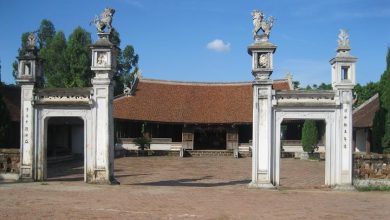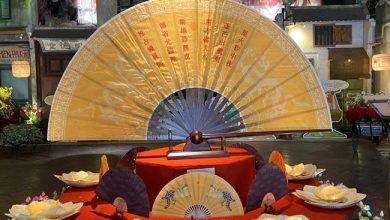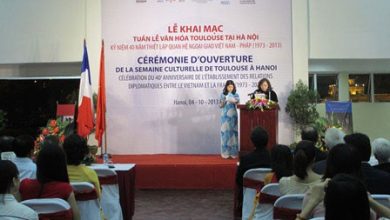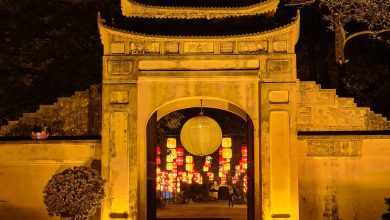New excavation results at Thăng Long Imperial Citadel
On the morning of 16 May 2019, the Thăng Long – Hà Nội Heritage Conservation Centre worked with the Institute of Archaeology of Vietnam to organize a scientific workshop titled “Preliminary report on the outcomes of the exploratory excavation of the Kính Thiên Palace area in 2018”. At the workshop, the archaeologists published a number of new discoveries that can open up various new directions for future research works on Thăng Long Imperial Citadel.

Participants discussing the new archaeological discoveries made at Thăng Long Imperial Citadel.
In order to shed more light on the location, scope of structure and value of the Thăng Long Imperial Citadel World Heritage Site, in 2018, as a follow-up to previous excavations conducted since 2011, the Thăng Long – Hà Nội Heritage Conservation Centre worked with the Vietnam Institute of Archaeology to carry out an excavation over an area of about 1000m2 in the northeastern part of the Kính Thiên Palace foundation. This excavation pit lies next to the 2017 pit, and as such bear resemblance in terms of structure and the layers of soil, relics and artefacts with vestiges found earlier.
Assoc. Prof. Tống Trung Tín, former director of the Vietnam Institute of Archaeology and now the President of the Vietnam Association of Archaeologists, believed that this is the excavation area with hitherto the deepest geological strata and a cultural layer which is about 7 meters deep containing cultural elements from the Đại La spanning over to the Lý, Trần, Lê sơ, Lê Trung hưng, Nguyễn until modern time. This is also a typical cultural stratum, testifying in relative entirety to the history of the Imperial Citadel of Thăng Long across different periods. However, some sections of this excavated pit were seriously damaged due to the digging, filling and leveling work carried out in the past. In terms of relics, the excavation has also revealed some vestiges of structures that date back to the Lý, Trần, Lê sơ and Lê Trung hưng periods. These structural vestiges have been substantially destroyed due to the presence of a solidly built deep-water streamlet that was built with embankments and square-section brick walls dating from the 17-18th centuries. A noteworthy find has been the vestige of a stone-built foundation of a structure whose function is yet to be identified, but whose importance to the main area of Kính Thiên Palace is clear.
The excavation also has unearthed different types of artefacts and structures made of various materials including fired clay, ceramics, metals and wood. Among these, tiles come in largest number, the most notable of which were the tiles decorated with dragons to be used on the palace roofs enameled with celadon and yellow glaze, together with the fairly intact ventilated bricks decorated with dragons. Many wooden structures found in the loop of the streamlet still have visible a gilded and red lacquered coat. Another important thing about this excavation was the discovery of multiple ceramic items of the Lê sơ and the Mạc dynasties.
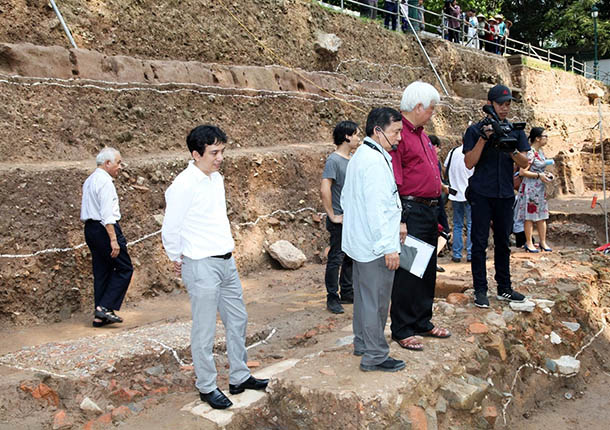
Participants surveying the excavation site.
The workshop also enjoyed active discussion and explanation proffered around the issues presented by the excavation team.
Dr. Phạm Quốc Quân, former director of the National History Museum, suggested that there should be connection between all the different excavation projects conducted to date in order to arrive at a cross-cutting, comprehensive view of the processes of excavation, documentation of architectural vestiges and exact evaluation that provides grounds for the restoration of the space of Kính Thiên Palace. There have been different hypotheses about the wooden objects found in this place, but he is more of the view that they were the remains of a wooden boat.
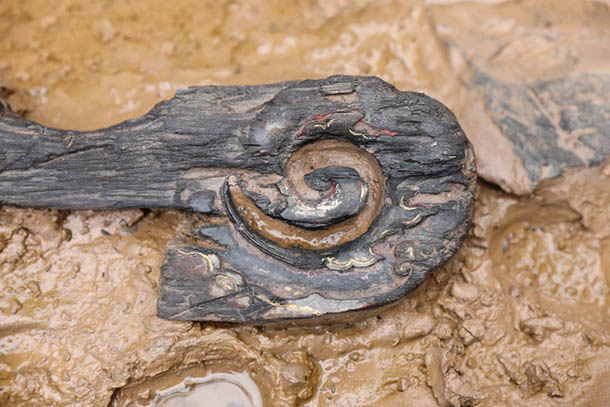
Wooden object with red lacquered and gilded coat.
According to Assoc. Pro. Bùi Minh Trí, Director of the Institute of Imperial Citadel Studies, the more excavation is conducted, the more sizeable and sophisticated the scope and geological strata of the Thăng Long Imperial Citadel prove to be. Therefore, more research is needed to clarify the floor plan of the relics of each period. In terms of the bodies of water found in the area, he believed that this can be vestige of a moat on account of the analogy between the Citadel and its counterparts in Beijing and Zhangan. He was also particularly impressed with the glazed ceramicware of the Mạc period found in this excavation.

Participants impressed with the collection of celadon and yellow tiles decorated with dragons of the Lê Sơ.
Talking about the solid stone-built foundation, Prof. Dr. Nguyễn Quang Ngọc associated it with a palace by the name of Ngọc Hà which according to the Hồng Đức Map was situated to the east of Kính Thiên Palace.
Historian Lê Văn Lan also suggested that as Thăng Long was a capital city of rivers and lakes, the discovery of vestiges of bodies of water and currents in the Forbidden City is all very natural. He notified the archaeologists to the need for research linking it to the vestiges of the lakes and wharfs lying in the vicinity of this excavation pit, found in the area of Hậu Lâu during the 1998 excavation so that images of a beautiful lakescape once existed in the back palaces of Forbidden City of Thăng Long could be envisioned.
From the perspective of the culture administration agency, Mr. Trần Đình Thành, deputy director general of the Cultural Heritage Department acknowledged that the excavation has opened up various research possibilities and directions on the architecture and landscape of Thăng Long Imperial Citadel. However, it is necessary to pay attention to the safeguarding of the relic by minimizing the environmental impacts on the relics and artefacts, treating and preserving them right in the process of excavation.
As he summarized the workshop, Prof. Dr. Lưu Trần Tiêu highly appreciated the latest archaeological discoveries at made at Thăng Long. As for next steps to be taken, the Thăng Long- Hà Nội Heritage Conservation Centre and the Institute of Archaeology should focus on research about spatial planning of Kính Thiên Palace and in that process shedding lights on such issues as the citadel corners, the moats, the Đan Trì yards and the axes flanking Kính Thiên – Đoan Môn, as well as connecting the floor plan and the overall space to facilitate the grounded restoration of Kính Thiên Palace.
Kim Yến

